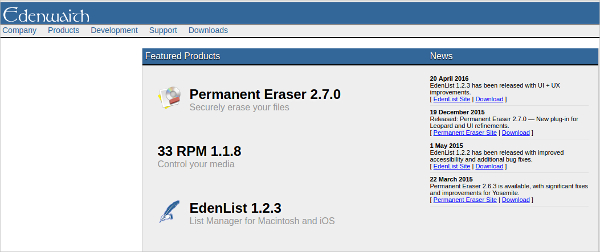

- Best permanent eraser for mac how to#
- Best permanent eraser for mac for mac#
- Best permanent eraser for mac Offline#
- Best permanent eraser for mac download#
- Best permanent eraser for mac free#
So what can be done to resolve this issue? Use a Mac file shredder. Our Macs have of course confidential information such as documents, passwords, and even software. It isn’t every day we also get the chance to clean-up the entire system unless of course, you want to trade in, sell, or give your Mac to another person.

This is almost similar to the Mac file shredder that we are going to discuss today.Įven if we religiously delete the files after using, it will be transferred to the trash bin wherein the files stay in there for as long as we remember to empty it. When you say or hear the word shred or shredder, the very first thing that comes to mind is to "destroy", "remove" or "bury".
Best permanent eraser for mac how to#
How to Use PowerMyMac File Shredder? Part 4. What is the Best Mac File Shredder? Part 3.
Best permanent eraser for mac download#
So here's a tip for you: Download CleanMyMac to quickly solve some of the issues mentioned in this article.Contents: Part 1. But to help you do it all by yourself, we’ve gathered our best ideas and solutions below.įeatures described in this article refer to the MacPaw site version of CleanMyMac X. How do you permanently delete a file from your Mac so that no trace of it is left behind? The answer is not as obvious as it sounds. You can’t just put it in the Trash then empty it. When you do that, all you are doing is telling macOS that the space on your drive occupied by that file is now available and removing the file from the directory. If you want to erase every trace of a file, you’ll need to go further. The easiest way to completely remove a file is to use a specially designed tool, a permanent eraser for your Mac. There are quite a few available, so here’s our list of the best. Naturally, we think CleanMyMac X is the best erase for your Mac. Its file shredding tool can quickly erase any file or files on your Mac and its Shredder tool is free.
Best permanent eraser for mac free#
In addition, CleanMyMac X has several other utilities, such as its app uninstaller, that can free up several gigabytes of space on your drive. It also has tools to improve your Mac’s performance and to protect it from malware. Why choose an app that only does one thing when you can have one that has so many useful tools? Here’s how the shredder works.
Best permanent eraser for mac for mac#
#PERMANENT FILE ERASER FOR MAC INSTALL#įollow the instructions on screen to install it, then launch it.Get a free version of CleanMyMac X - the Shredder is a part of the app.This method overwrites the file with random zeroes and ones. Choose Shredder at the bottom of the sidebar.ĭid you know CleanMyMac X can improve privacy on your Mac in other ways. It can remove chat logs from messaging apps like Messages and Skype. And it can get rid of browsing data like cookies, auto-fill form information and browsing history with just a few clicks. MacClean is another tool designed to free up space on your Mac, improve its performance and protect your privacy.
Best permanent eraser for mac Offline#
Its file eraser tool, according to its developer, will “remove out of date and offline files.” However, it doesn’t explain whether that removal process is a secure erase and whether it will “shred” the file leaving no trace behind. Unlike CleanMyMac X and MacClean, Permanent Eraser only has one function: to securely delete files. It does that by overwriting the file multiple times, in a similar manner to the way the Finder’s “Secure Empty Trash” used to do. In addition, it scrambles the original file name, reduces the file size to zero and removes it from the file directory, erasing all trace of it from your Mac.

Since El Capitan OSX, Apple has removed the option to “Secure Empty Trash.” Looks like there’s been lots of complaints after people trashed their important files irrecoverably. Also, overwriting files works differently on SSDs There’s a way to enable the said feature using the Terminal, but it’s too technical for most of us. This is another tool that is focused only on permanently erasing files.


 0 kommentar(er)
0 kommentar(er)
